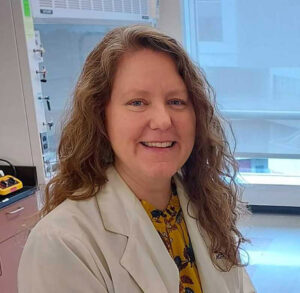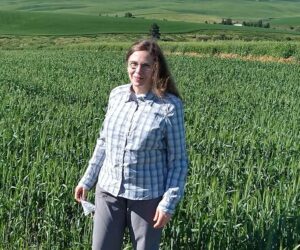By Amber Hauvermale, Alison Thompson, and Camille Steber
An alternative to the falling numbers test may soon be born from a multisector collaboration including producers, Washington State University (WSU), U.S. Department of Agriculture’s Agricultural Research Service (USDA-ARS), and industry partners.
The wheat industry uses the falling numbers test to detect elevated alpha-amylase enzyme levels in wheat grain to determine quality and assign economic discounts based on market dynamics. Low falling numbers is caused by preharvest sprouting (PHS), a result of rain after grain maturity, or late maturity alpha-amylase (LMA), a result of cool temperatures and/or large temperature swings during grain filling.
While the frequency of low falling in 2016, the falling numbers (FN) problem in the U.S. was widespread, impacting farmers in Idaho, Oregon, Colorado and Montana, as well as those in Washington. These weather-related FN events, caused by PHS and or LMA, cost Washington farmers alone more than $140 million in lost revenue. In response to the collective grower outcry resulting from the 2016 FN crisis, a “Falling Number Summit” was organized to give producers and those in the wheat industry a platform to communicate concerns and needs to university and USDA researchers. The following top priority needs were identified: (1) improve the FN test; (2) develop alternatives to the FN test; (3) breed for resistance to PHS and LMA; and (4) improve communication and coordination between researchers and the industry.
The quest for a rapid alternative test began at the Falling Number Summit in 2017. At this meeting, a more rapid and accurate test emerged as a top priority. This is because the FN method isn’t fast enough to enable segregation of high and low FN grain as it arrives at the elevator. Segregation at the elevator is critical because, like rotten apples, it takes very little low FN grain to spoil a lot of sound grain. Paul Katovich of HighLine Grain Growers made clear the need for a “red light/green light” test to preserve the value of sound grain in a bad season. Alex McGregor of The McGregor Company thought an immunoassay might be a viable option for a rapid alternative test. Immunoassays are used ubiquitously in medical settings for a wide range of applications and are becoming more routine in crop testing. However, the primary reason this technology is a good alternative to the FN test is because it is specific, sensitive and quantitative.
McGregor and the Washington Grain Commission (Mary Palmer Sullivan and commission-
ers) worked with Jim Moyer, WSU’s College of Agricultural, Human, and Natural Resource
Sciences associate dean of research in 2017, and others at WSU to spearhead a project on the immunoassay. Funds from the Orville A. Vogel Wheat Research Fund and industry support were used to jump start the project until additional resources from USDA-ARS and other extramural sources could be secured. The show of support from all wheat industry sectors was critical and demonstrated the collaborative effort required to develop solutions to complex industry problems.
Research efforts at WSU started in 2018 with the antibody development and immunoassay
platforms that served as the proof-of-concept needed to attract EnviroLogix Inc. as a collabora-
tor. EnviroLogix is a company that develops tools for the crop industry (envirologix.com) and specializes in the production of affordable diagnostic tests, including immuno-products using antibodies. An example is the vomitoxin (DON) test used to prevent contamination of wheat grain with Fusarium Head Blight.

Since the partnership with EnviroLogix in 2020, interviews and surveys have been conducted with representatives from the wheat industry who are targeted users. Initial feedback informed the FN research team (Drs. Arron Carter, Amber Hauvermale, Drew Lyon, Andy McCubbin, Clark Neely, Michael Pumphrey, Zhiwu Zhang, Byung-Kee Baik, Kim Garland- Campbell, Xianran Li, Camille Steber, and Alison Thompson) that a diagnostic test should be used for grain segregation at harvest to maintain high FN from point of origin to point of delivery.
Representatives from EnviroLogix visited in April 2023, where industry partners conveyed to them that there is a market and end-user need for their product as a pre- and post-management tool for the falling numbers problem. EnviroLogix is targeting a test to be cheaper,
faster and more accurate than the current test, with a five-minute run time, an estimated capital equipment cost of $10,000 or less for the digital reader, and a per-test consumable cost estimated to be less than the FN test. For growers, this may mean less delay at the elevator during harvest and reduced spoiling of otherwise quality grain.
Researchers hope to begin preliminary beta-testing with cooperators this summer to develop a workflow that can be used efficiently to segregate low FN grain at the elevators. Further collaborations with EnviroLogix are ongoing to develop additional, higher-throughput
tests to aid breeders with PHS- and LMA-resistant variety development. The success of the project will depend on continued research efforts, collaboration and improved communication throughout this multisector team. To help achieve these results, Washington growers
can participate in the following ways:
- Attendance at conferences/meetings to receive updates on causes of low FN and provide feedback on preliminary tests and methods.
- Participating in surveys when given at meetings.
- Encouraging your elevators to participate in preliminary tests as available.
- Letting the research team know when you have a FN problem ([email protected]). This information is critical for obtaining important trial locations and grain samples.
This article originally appeared in the June 2023 issue of Wheat Life Magazine.

Amber Hauvermale, Ph.D.
Amber L. Hauvermale, Ph.D., is a research assistant professor in the Department of Crop and Soil Sciences, which is part of the College of Agricultural, Human, and Natural Resource Sciences at Washington State University.

Alison Thompson, Ph.D.
Alison L. Thompson, Ph.D., is a plant geneticist and research biologist for the U.S. Department of Agriculture’s Agricultural Research Service (USDA-ARS) Wheat Health, Genetics and Quality Research Unit, based in Pullman. Thompson works on the low falling numbers problem in wheat, as well as characterize adaptation responses of wheat and barley to changing environmental conditions.

Camille Steber, Ph.D.
Camille M. Steber, Ph.D., is a research molecular geneticist and the principal investigator for the Steber Laboratory, which is part of the USDA-ARS Wheat Health, Genetics and Quality Unit; and adjunct faculty in the Department of Crop and Soil Sciences at Washington State University. Read more about Dr. Steber.
